Horticultural Activity: Its Contribution to Stress Recovery and Wellbeing for Children
Abstract
1. Introduction
2. Materials and Methods
2.1. Participants
2.2. Study Protocol
2.3. Physiological Measurements
2.3.1. Heart Rate Variability
2.3.2. Skin Conductance (SC)
2.3.3. Skin Temperature
2.4. Psychological Measurements
2.4.1. Semantic Differential Questionnaire (SD)
2.4.2. State–Trait Anxiety Inventory (STAI)
2.5. Statistical Analysis
3. Results
3.1. Physiological Measurements
3.1.1. Heart Rate Variability (HRV)
3.1.2. Skin Conductance (SC)
3.1.3. Skin Temperature (SKT)
3.2. Psychological Measurements
3.2.1. Semantic Questionnaire (SD)
3.2.2. State–Trait Anxiety Inventory (STAI)
4. Discussion
5. Conclusions
Author Contributions
Funding
Acknowledgments
Conflicts of Interest
References
- WHO. Constitution of theWorld Health Organization: Basic Document; WHO: Geneva, Switzerland, 2019; Available online: https://www.who.int/governance/eb/who_constitution_en.pdf (accessed on 10 September 2019).
- Soga, M.; Gaston, K.J.; Yamaura, Y. Gardening is beneficial for health: A meta-analysis. Prev. Med. Reports 2017, 5, 92–99. [Google Scholar] [CrossRef] [PubMed]
- Kaplan, R. The psychological benefits of nearby nature. In The Role of Horticulture in Human Well-Being and Social Development; Timber Press: Portland, OR, USA, 1992; pp. 125–133. [Google Scholar]
- Ulrich, R.S. Biophilia, biophobia, and natural landscapes. In The Biophilia Hypothesis; Kellert, S.R., Wilson, E.O., Eds.; Island Press: Washington DC, US, 1993; pp. 73–137. [Google Scholar]
- Berto, R. The role of nature in coping with psycho-physiological stress: A literature review on restorativeness. Behav. Sci. 2014, 4, 394–409. [Google Scholar] [CrossRef] [PubMed]
- Groenewegen, P.P.; Van Den Berg, A.E.; De Vries, S.; Verheij, R.A. Vitamin G: Effects of green space on health, well-being, and social safety. BMC Public Health 2006, 6, 149. [Google Scholar] [CrossRef] [PubMed]
- Kaplan, S. The restorative benefits of nature Toward an integrative framework. J. Environ. Psychol. 1995, 15, 169–182. [Google Scholar] [CrossRef]
- Ulrich, R.S.; Simons, R.F.; Losito, B.D.; Fiorito, E.; Miles, M.A.; Zelson, M. Stress recovery during exposure to natural and urban environments. J. Environ. Psychol. 1991, 11, 201–230. [Google Scholar] [CrossRef]
- Elsadek, M.; Sun, M.; Sugiyama, R.; Fujii, E. Cross-cultural comparison of physiological and psychological responses to different garden styles. Urban For. Urban Green. 2019, 38, 74–83. [Google Scholar] [CrossRef]
- Elsadek, M.; Liu, B.; Lian, Z. Green façades Their contribution to stress recovery and well-being in high- density cities. Urban For. Urban Green. 2019, 46. [Google Scholar] [CrossRef]
- Hartig, T.; Mitchell, R.; de Vries, S.; Frumkin, H. Nature and Health. Annu. Rev. Public Health 2014, 35, 207–228. [Google Scholar] [CrossRef]
- Victor, C.; Amy, B.; Donnerstein, E. Children, adolescents, and the media: Health effects. Pediatr. Clin. N. Am. 2012, 59, 533–587. [Google Scholar]
- Merikangas, K.; He, J.-P.; Burstein, M.; Swanson, S.A.; Avenevoli, S.; Ciu, L.; Benjet, C.; Georgiades, K.; Swendsen, J. Lifetime Prevalence of Mental Disorders in U.S. Adolescents: Results from the National Comorbidity Survey Replication–Adolescent Supplement (NCS-A). J. Am. Acad. Child Adolesc. Psychiatry 2010, 49, 980–989. [Google Scholar] [CrossRef]
- Bishop, B.P. Nature for mental health and social inclusion. Disabil. Stud. Q. 2012, 33, 1375. [Google Scholar] [CrossRef]
- Frumkin, H. Beyond toxicity: Human health and the natural environment. Am. J. Prev. Med. 2001, 20, 234–240. [Google Scholar] [CrossRef]
- Clatworthy, J.; Hinds, J.; Camic, P.M. Gardening as a mental health intervention: A review. Ment Health Rev. J. 2013, 18, 214–225. [Google Scholar] [CrossRef]
- Wang, D.; MacMillan, T. The benefits of gardening for older adults: A systematic review of the literature. Act. Adapt Aging 2013, 37, 153–181. [Google Scholar] [CrossRef]
- Wood, C.J.; Pretty, J.; Griffin, M. A case-control study of the health and well-being benefits of allotment gardening. J. Public Health 2016, 38, e336–e344. [Google Scholar] [CrossRef]
- Van Den Berg, A.E.; Van Winsum-Westra, M.; De Vries, S.; Van Dillen, S.M. Allotment gardening and health: A comparative survey among allotment gardeners and their neighbors without an allotment. Environ. Health 2010, 9, 74. [Google Scholar] [CrossRef]
- Wilson, J.F.; Christensen, K.M. The Relationship between gardening and depression among individuals with disabilities. J. Ther. Hortic. 2011, 21, 28–41. [Google Scholar]
- Gonzalez, M.T.; Hartig, T.; Patil, G.G.; Martinsen, E.W.; Kirkevold, M. A prospective study of existential issues in therapeutic horticulture for clinical depression. Issues Ment Health Nurs. 2011, 32, 73–81. [Google Scholar] [CrossRef]
- Lee, M.S.; Lee, J.; Park, B.J.; Miyazaki, Y. Interaction with indoor plants may reduce psychological and physiological stress by suppressing autonomic nervous system activity in young adults: A randomized crossover study. J. Physiol. Anthropol. 2015, 34, 1–6. [Google Scholar] [CrossRef]
- Brinker, D. Adapting an existing greenhouse for accessibility by an older adult popolation with developmental disabilities. J. Ther. Hortic. 2000, 11, 42–47. [Google Scholar]
- Louv, R. Last Child in the Woods: Saving Our Children from Nature-Deficit Disorder; Algonquin Books: Chapel Hil, NC, USA, 2008; ISBN 9781565126053. [Google Scholar]
- Zhang, L.; Sun, S.; Xing, B.; Luo, R.; Zhang, K. Using psychophysiological measures to recognize personal music emotional experience. Front. Inf. Technol. Electron. Eng. 2019, 20, 964–974. [Google Scholar] [CrossRef]
- Wang, D.; Zhang, H.; Arens, E.; Huizenga, C. Observations of upper-extremity skin temperature and corresponding overall-body thermal sensations and comfort. Build. Environ. 2007, 42, 3933–3943. [Google Scholar] [CrossRef]
- Kim, H.G.; Cheon, E.J.; Bai, D.S.; Lee, Y.H.; Koo, B.H. Stress and heart rate variability: A meta-analysis and review of the literature. Psychiatry Investig. 2018, 15, 235–245. [Google Scholar] [CrossRef] [PubMed]
- Malik, M.; John, C.; Thomas, B.; Günter, B.; Sergio, C.; Richard, J.; Philippe, C.; Ernest, L.; Robert, E. Guidelines heart rate variability standards of measurement, physiological interpretation, and clinical use. Eur. Heart J. 1996, 17, 354–381. [Google Scholar] [CrossRef]
- Evrengül, H.; Tanriverdi, H.; Dursunoglu, D.; Kaftan, A.; Kuru, O.; Unlu, U.; Kilic, M. Time and frequency domain analyses of heart rate variability in patients with epilepsy. Epilepsy Res. 2005, 63, 131–139. [Google Scholar] [CrossRef] [PubMed]
- Billman, G.E. The LF/HF ratio does not accurately measure cardiac sympatho-vagal balance. Front. Physiol. 2013, 4, 1–5. [Google Scholar] [CrossRef] [PubMed]
- Berntson, G.G.; Thomas Bigger, J.; Eckberg, D.L.; Grossman, P.; Kaufmann, P.G.; Malik, M.; Nagaraja, H.N.; Porges, S.W.; Saul, J.P.; Stone, P.H.; et al. Heart rate variability: Origins methods, and interpretive caveats. Psychophysiology 1997, 34, 623–648. [Google Scholar] [CrossRef]
- Shaffer, F.; McCraty, R.; Zerr, C.L. A healthy heart is not a metronome: An integrative review of the heart’s anatomy and heart rate variability. Front. Psychol. 2014, 5, 1040. [Google Scholar] [CrossRef]
- Shaffer, F.; Ginsberg, J.P. An overview of heart rate variability metrics and norms. Front. Public Health 2017, 5, 258. [Google Scholar] [CrossRef]
- Tarvainen, M.P.; Niskanen, J.P.; Kubios, H.R.V. Biosignal Analysis and Medical Imaging Group (BSAMIG); Department of Applied Physics, University of Eastern Finland: Joensuu, Finland, 2012; pp. 1–44. [Google Scholar]
- Andrasik, F.; Rime, C. Biofeedback. In Pain Management; Elsevier: Philadelphia, PA, USA, 2007. [Google Scholar]
- Benedek, M.; Kaernbach, C.A. Continuous measure of phasic electrodermal activity. J. Neurosci. Methods 2010, 190, 80–91. [Google Scholar] [CrossRef]
- Kreibig, S.D. Autonomic nervous system activity in emotion: A review. Biol. Psychol. 2010, 84, 394–421. [Google Scholar] [CrossRef] [PubMed]
- Boucsein, W. Electrodermal Activity; Springer Science & Business Media: Berlin/Heidelberg, Germany, 2012. [Google Scholar]
- Gatti, E.; Calzolari, E.; Maggioni, E.; Obrist, M. Emotional ratings and skin conductance response to visual, auditory and haptic stimuli. Sci. Data 2018, 5, 180120. [Google Scholar] [CrossRef] [PubMed]
- Herborn, K.A.; Graves, J.L.; Jerem, P.; Evans, N.P.; Nager, R.; McCafferty, D.J.; McKeegan, D.E.F. Skin temperature reveals the intensity of acute stress. Physiol. Behav. 2015, 152, 225–230. [Google Scholar] [CrossRef] [PubMed]
- Osgood, C.E. The Nature and measurement of meaning. Psychol. Bull. 1952, 49, 197–237. [Google Scholar] [CrossRef]
- Iwata, N.; Mishima, N. Reliability of the State-Trait Anxiety Inventory, Form Y in Japanese samples. Psychol. Rep. 1999, 84, 494–496. [Google Scholar] [CrossRef]
- Julian, L.J. Measures of anxiety: State-Trait Anxiety Inventory (STAI), Beck Anxiety Inventory (BAI), and Hospital Anxiety and Depression Scale-Anxiety (HADS-A). Arthritis Care Res. 2011, 63 (Suppl. S11), S467–S472. [Google Scholar] [CrossRef]
- Kang, Y.H. The effects of horticultural therapy on the well-being and hope of women in rural Korea. J. Nurs. Care 2013, 3. [Google Scholar] [CrossRef]
- Gigliotti, C.M.; Jarrott, S.E.; Yorgason, J. Harvesting Health: Effects of Three Types of Horticultural Therapy Activities for Persons with Dementia. Dementia 2004, 3, 161–180. [Google Scholar] [CrossRef]
- Critchley, H.; Elliott, R.; Mathias, C.; Dolan, R.J. Neural activity relating to generation and representation of galvanic skin conductance responses: A functional magnetic resonance imaging study. J. Neurosci. 2000, 20, 3033–3040. [Google Scholar] [CrossRef]
- Setz, C.; Arnrich, B.; Schumm, J.; Marca, R.L.; Tröster, G.; Ehlert, U. Discriminating stress from cognitive load using a wearable EDA device. IEEE Trans. Inf. Technol. Biomed. 2010, 14, 410–417. [Google Scholar] [CrossRef]
- Tsunetsugu, Y.; Park, B.J.; Miyazaki, Y. Trends in research related to shinrin-yoku (taking in the forest atmosphere or forest bathing) in Japan. Environ. Health Prev. Med. 2010, 15, 27–37. [Google Scholar] [CrossRef] [PubMed]
- Moore, E.O. A Prison Environment’s Effect on Health Care Service Demands. J. Environ. Syst. 1981, 11, 17–34. [Google Scholar] [CrossRef]
- Elsadek, M.; Fujii, E. People’s Psycho -physiological responses to plantscape colors stimuli: A pilot study. Int. J. Psychol. Behav. Sci. 2014, 4, 70–78. [Google Scholar]
- Elsadek, M.; Sayaka, S.; Fujii, E.; Koriesh, E.; Moghazy, E.; ElFatah, Y. Human emotional and psycho-physiological responses to plant color stimuli. J. Food Agric. Environ. 2013, 11, 1584–1591. [Google Scholar]
- Igarashi, M.; Song, C.; Ikei, H.; Miyazaki, Y. Effect of stimulation by foliage plant display images on prefrontal cortex activity: A comparison with stimulation using actual foliage plants. J. Neuroimaging 2015, 25, 127–130. [Google Scholar] [CrossRef]
- Koga, K.; Iwasaki, Y. Psychological and physiological effect in humans of touching plant foliage—Using the semantic differential method and cerebral activity as indicators. J. Physiol. Anthropol. 2013, 32, 7. [Google Scholar] [CrossRef]
- Franco, L.S.; Shanahan, D.F.; Fuller, R.A. A review of the benefits of nature experiences: More than meets the eye. Int. J. Environ. Res. Public Health 2017, 14, 864. [Google Scholar] [CrossRef]
- Elsadek, M.; Sun, M.; Fujii, E. Psycho-physiological responses to plant variegation as measured through eye movement, self-reported emotion and cerebral activity. Indoor Built Environ. 2017, 26, 758–770. [Google Scholar] [CrossRef]
- Elsadek, M.; Liu, B.; Lian, Z.; Junfang, X. The influence of urban roadside trees and their physical environment on stress relief measures A field experiment in Shanghai. Urban For. Urban Green. 2019, 42, 51–60. [Google Scholar] [CrossRef]
- Park, B.J.; Furuya, K.; Kasetani, T.; Takayama, N.; Kagawa, T.; Miyazaki, Y. Relationship between psychological responses and physical environments in forest settings. Landsc. Urban Plan. 2011, 102, 24–32. [Google Scholar] [CrossRef]
- Ulrich, R.S. View through a window may influence recovery from surgery. Science 1984, 224, 420. [Google Scholar] [CrossRef] [PubMed]
- Ferrini, F. Horticultural therapy and its effect on people’s health. Adv. Hortic. Sci. 2003, 17, 77–87. [Google Scholar]
- Elings, M. People-plant interaction: The physiological, psychological and sociological effects of plants on people. In Farming Health; Springer: Berlin/Heidelberg, Germany, 2006; pp. 43–55. [Google Scholar]
- Hall, C.R.; Knuth, M.J. An update of the literature supporting the well-being benefits of plants: Part 2 physiological health henefits. J. Environ. Hortic. 2019, 37, 63–73. [Google Scholar]

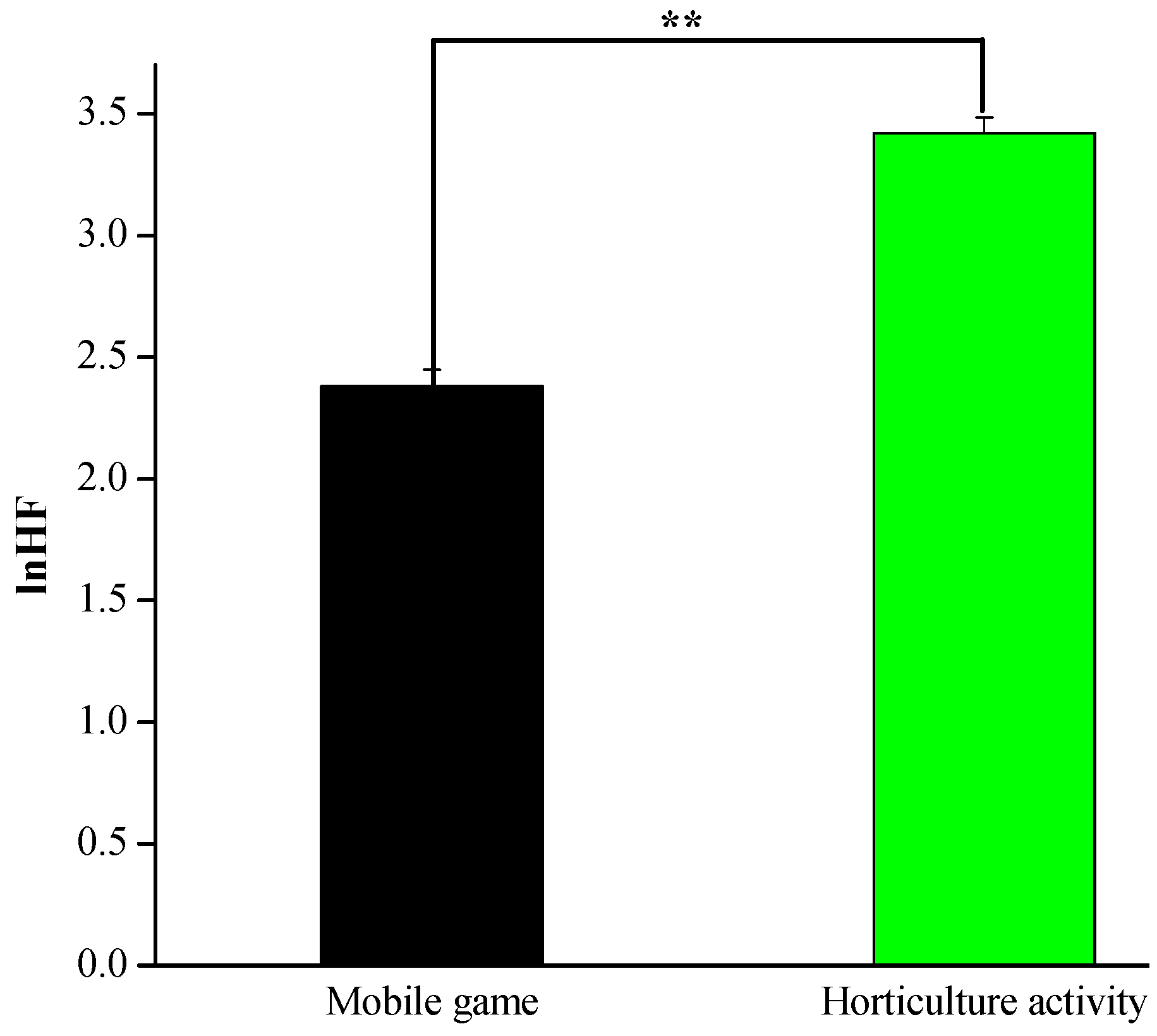
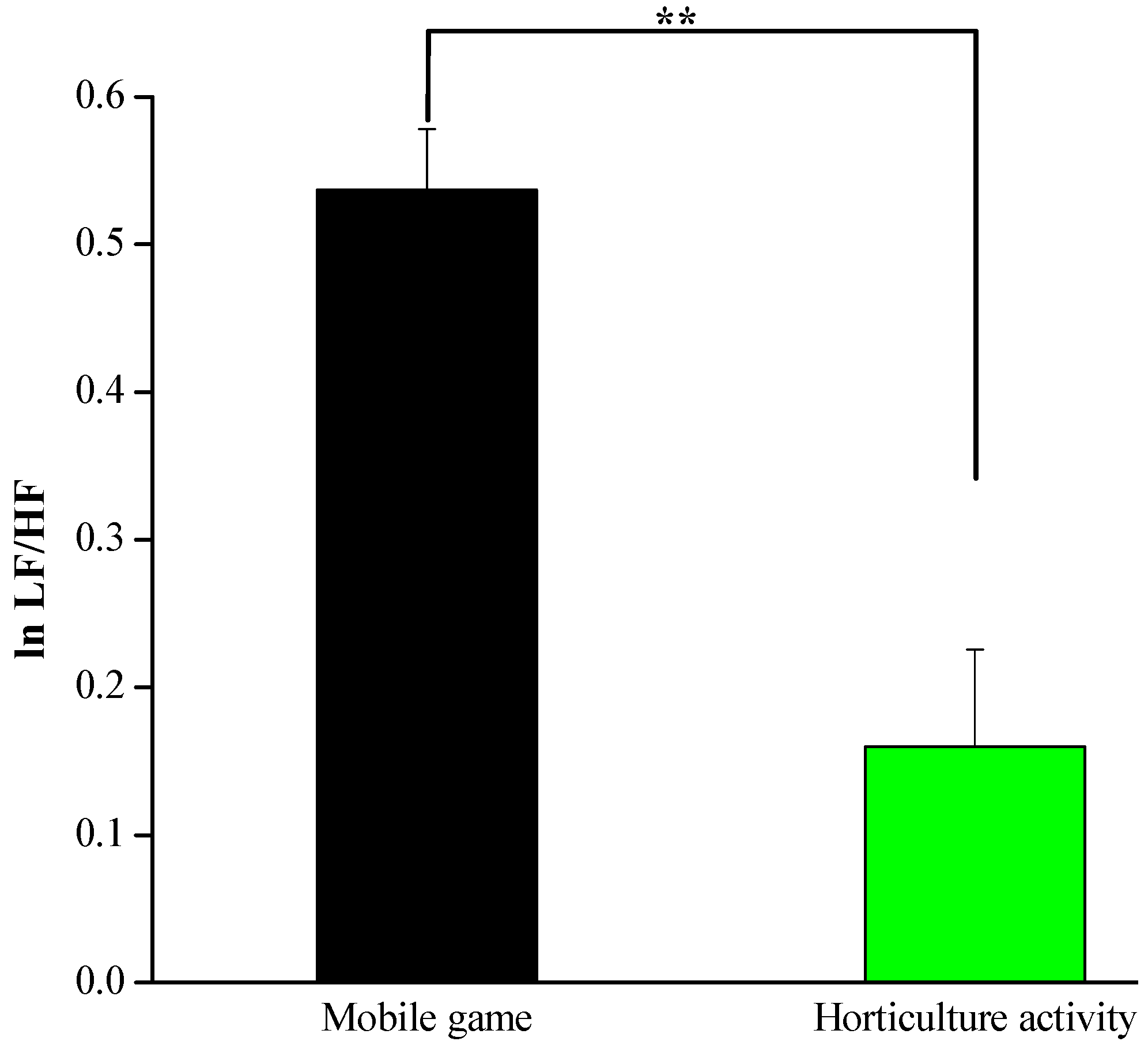
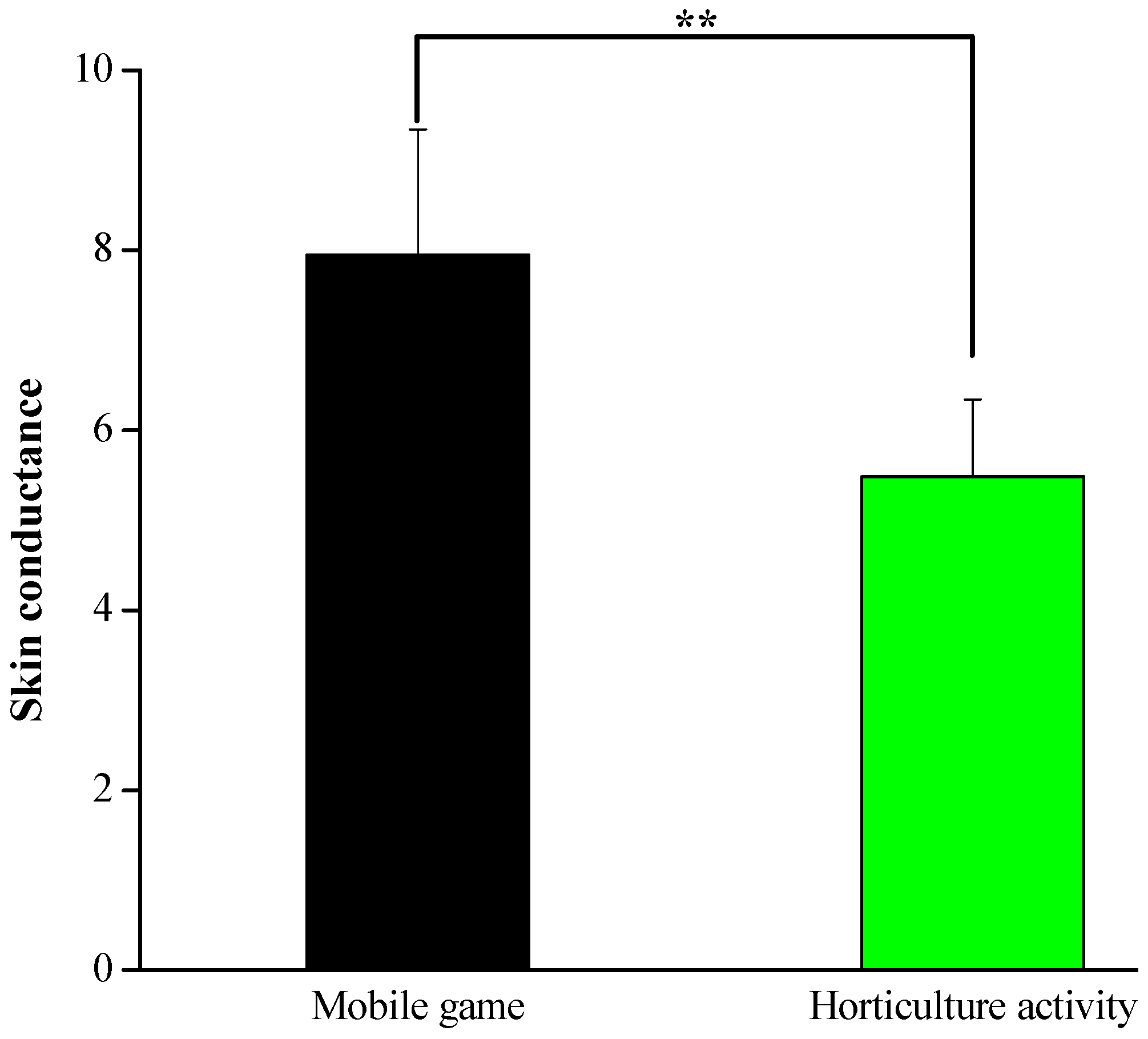
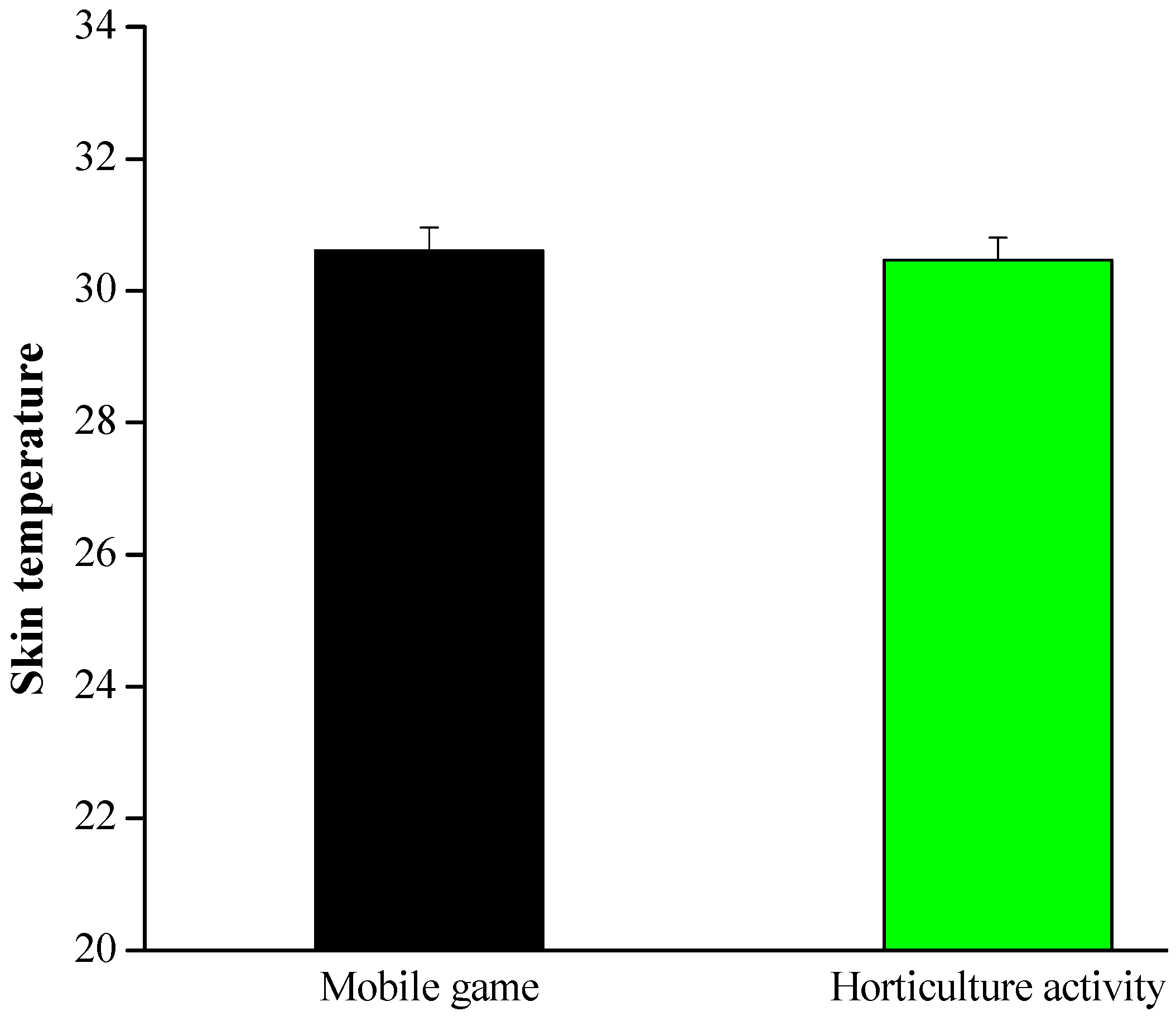
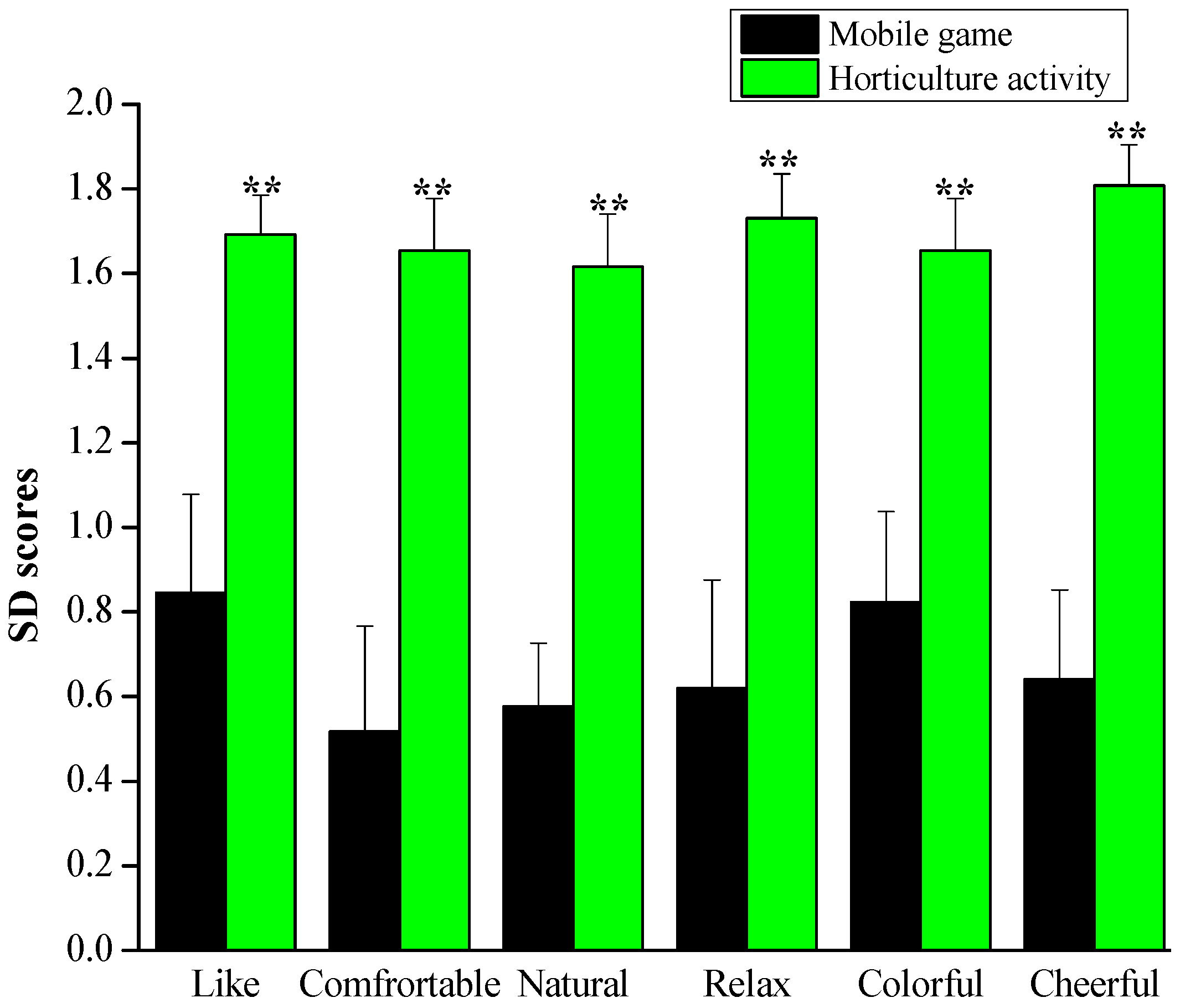
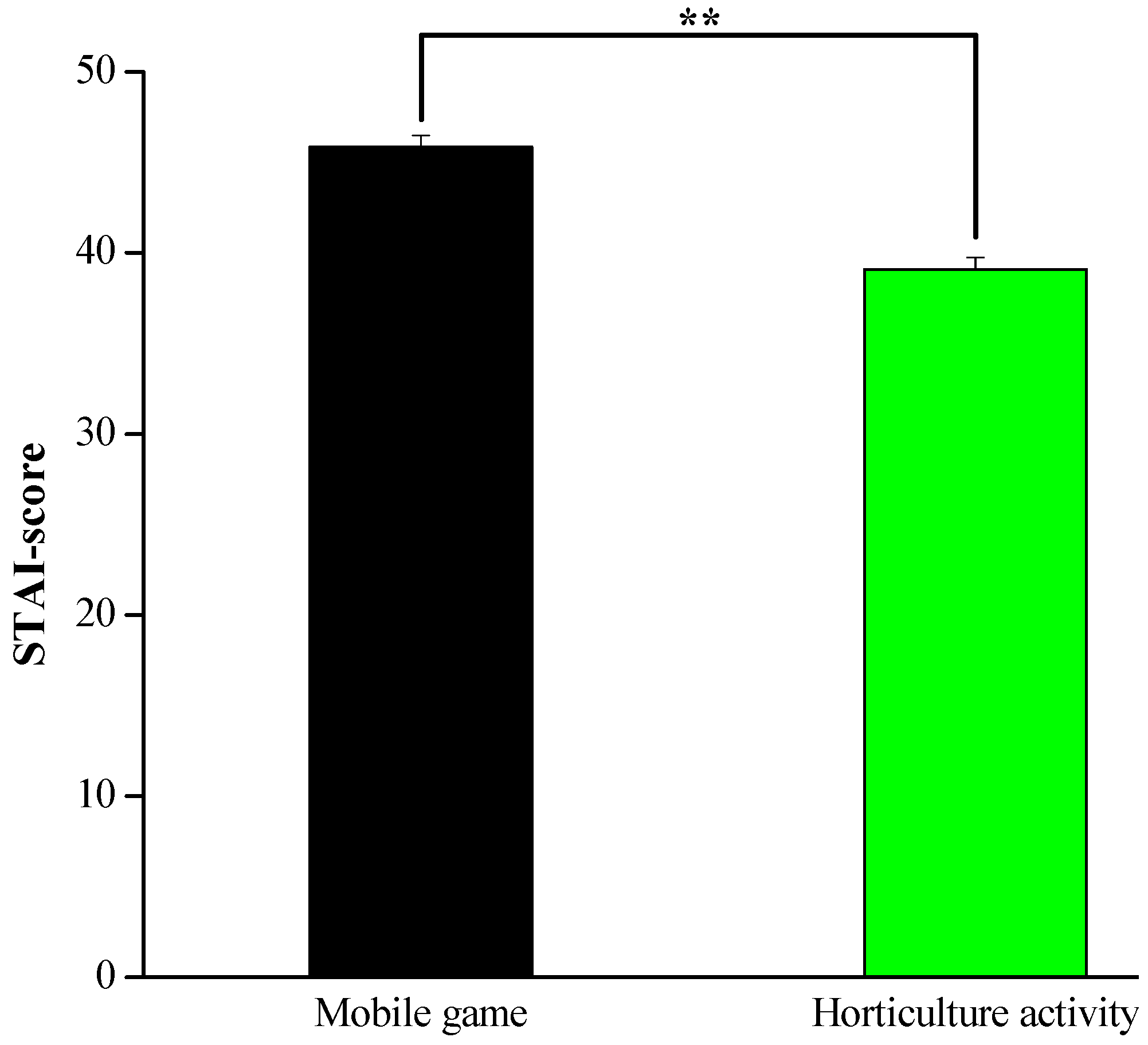
© 2020 by the authors. Licensee MDPI, Basel, Switzerland. This article is an open access article distributed under the terms and conditions of the Creative Commons Attribution (CC BY) license (http://creativecommons.org/licenses/by/4.0/).
Share and Cite
Shao, Y.; Elsadek, M.; Liu, B. Horticultural Activity: Its Contribution to Stress Recovery and Wellbeing for Children. Int. J. Environ. Res. Public Health 2020, 17, 1229. https://doi.org/10.3390/ijerph17041229
Shao Y, Elsadek M, Liu B. Horticultural Activity: Its Contribution to Stress Recovery and Wellbeing for Children. International Journal of Environmental Research and Public Health. 2020; 17(4):1229. https://doi.org/10.3390/ijerph17041229
Chicago/Turabian StyleShao, Yuhan, Mohamed Elsadek, and Binyi Liu. 2020. "Horticultural Activity: Its Contribution to Stress Recovery and Wellbeing for Children" International Journal of Environmental Research and Public Health 17, no. 4: 1229. https://doi.org/10.3390/ijerph17041229
APA StyleShao, Y., Elsadek, M., & Liu, B. (2020). Horticultural Activity: Its Contribution to Stress Recovery and Wellbeing for Children. International Journal of Environmental Research and Public Health, 17(4), 1229. https://doi.org/10.3390/ijerph17041229






